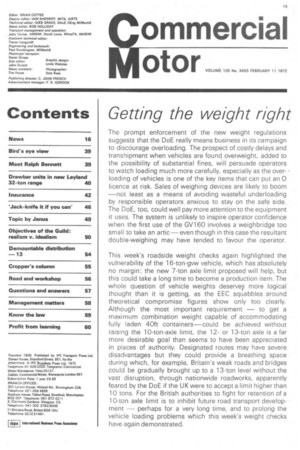Getting the weight right
Page 17

If you've noticed an error in this article please click here to report it so we can fix it.
The prompt enforcement of the new weight regulations suggests that the DoE really means business in its campaign to discourage overloading. The prospect of costly delays and transhipment when vehicles are found overweight, added to the possibility of substantial fines, will persuade operators to watch loading much more carefully, especially as the overloading of vehicles is one of the key items that can put an 0 licence at risk. Sales of weighing devices are likely to boom —not least as a means of avoiding wasteful underloading by responsible operators anxious to stay on the safe side. The DoE, too, could well pay more attention to the equipment it uses. The system is unlikely to inspire operator confidence when the first use of the GV160 involves a weighbridge too small to take an artic— even though in this case the resultant double-weighing may have tended to favour the operator.
This week's roadside weight checks again highlighted the vulnerability of the 16-ton-gvw vehicle, which has absolutely no margin; the new 7-ton axle limit proposed will help, but this could take a long time to become a production item. The whole question of vehicle weights deserves more logical thought than it is getting, as the EEC squabbles around theoretical compromise figures show only too clearly. Although the most important requirement — to get a maximum combination weight capable of accommodating fully laden 40ft containers—could be achieved without raising the 10-ton-axle limit, the 12or 13-ton axle is a far more desirable goal than seems to have been appreciated in places of authority. Designated routes may have severe disadvantages but they could provide a breathing space during which, for example, Britain's weak roads and bridges could be gradually brought up to a 13-ton level without the vast disruption, through nationwide roadworks, apparently feared by the DoE if the UK were to accept a limit higher than 10 tons. For the British authorities to fight for retention of a 10-ton axle limit is to inhibit future road transport development — perhaps for a very long time, and to prolong the vehicle loading problems which this week's weight checks have again demonstrated.








































































































